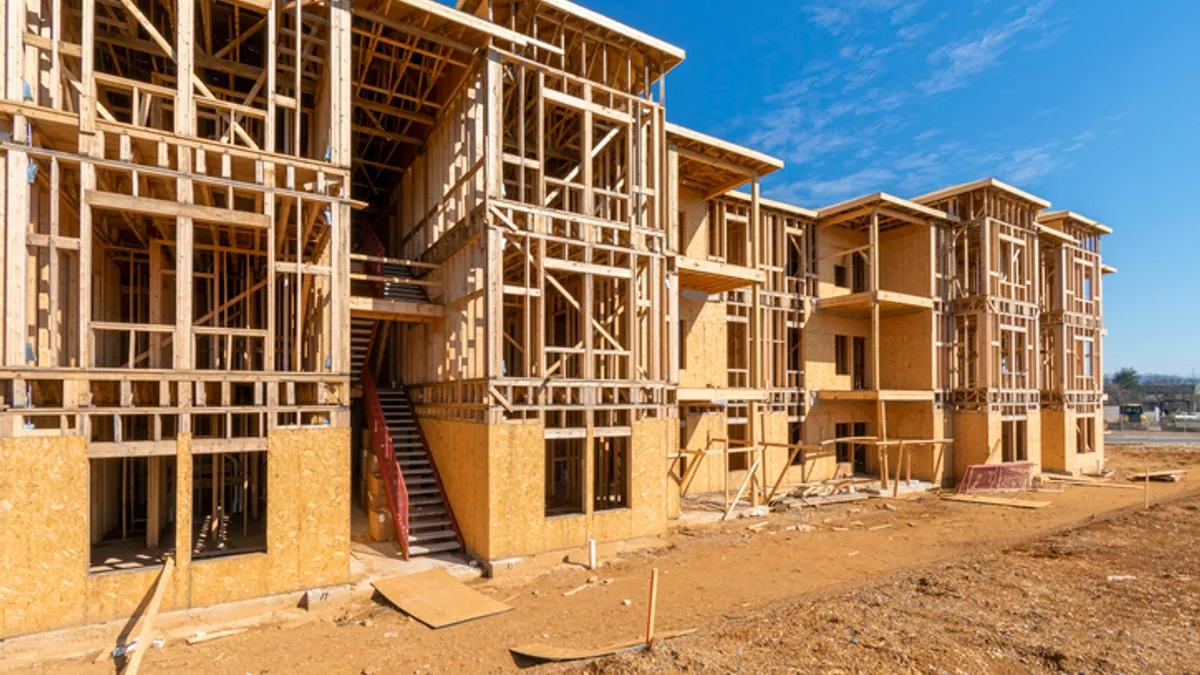Apartment growth is shifting to counties with lower population densities, according to the latest National Association of Home Builders Home Building Geography Index for the first quarter of 2025, released earlier this month.
The market share of apartment starts in large metro core counties continued a long-term downward trend. In 2016, it was 45.1%. Since then, it has fallen 9.4 percentage points to a 35.5% share, the lowest level since the HBGI's inception.
HBGI is a quarterly measurement of building conditions across the country. It uses county-level information about single-family and multifamily permits to gauge housing construction growth in various urban and rural geographies.
NAHB Chief Economist Robert Dietz told Multifamily Dive that the HBGI has shown a significant drop in construction for large metro core counties, flat starts for large suburbs, growth for exurbs, solid growth for small metro core and large percentage gains (although still small shares) for rural areas over the past nine years.
“For migration in general, since COVID, there’s been a broader shift for multifamily construction moving out, in terms of market share, to lower-density geographies, which are in turn more affordable,” Dietz told Multifamily Dive.
The market share for core counties of large metro areas fell three percentage points in Q1. That decline led to a rise for all other urban and rural geographic areas during the year's first three months.
Drivers of change
There isn’t just one catalyst behind the movement of construction to less-dense areas. With a strong need for affordable, attainable housing, Dietz said that the “multifamily market is exhibiting strength in lower-cost areas where housing supply can more readily expand.”
Demographic trends are also a factor. The percentage of renters age 30 or older is 72%, an all-time high, according to John Burns Research & Consulting. “The older renters want maybe more of a suburban life versus urban,” Eric Finnigan, vice president of demographics research at the Irvine, California-based firm, told Multifamily Dive.
Capital is also a major player in the drive to build further out. Charleston, South Carolina-based apartment developer Woodfield Development doesn’t push beyond the exurbs, but founding partner Greg Bonifield sees equity chasing what he calls a basis play with other developers.
Share of apartment starts by area
| Area | Q1 2016 | Q1 2025 |
| Large Metro - Core County | 45.1% | 35.5% |
| Large Metro - Suburban County | 26.2% | 25.7% |
| Large Metro - Outlying Areas | 3.0% | 4.7% |
| Small Metro - Core County | 18.8% | 24.1% |
| Small Metro - Outlying County | 3.2% | 5.1% |
| Micro County | 2.9% | 3.7% |
| Non-Metro/Micro County | 0.8% | 1.2% |
SOURCE: NAHB
“There are buckets of money out there that want to deploy into new construction if they can hit a certain basis per unit,” Bonifield told Multifamily Dive.
Land costs are one key element driving up costs, so it makes sense that developers would start moving to less dense areas where dirt is typically cheaper.
“On the basis play, the further you go out, you can build a product at a lower cost, which is what a fair amount of capital is focused on doing,” Bonifield said.
Click here to sign up to receive multifamily and apartment news like this article in your inbox every weekday.













